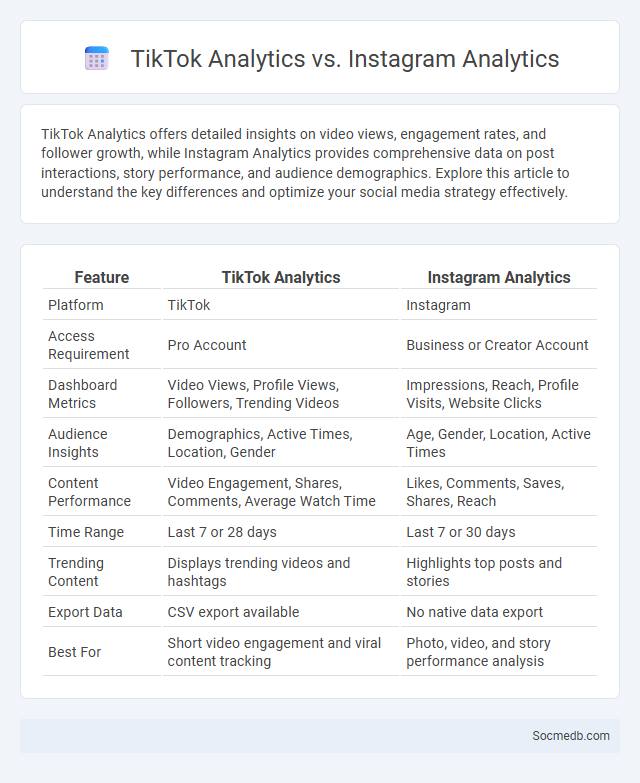
Photo illustration: TikTok Analytics vs Instagram Analytics
TikTok Analytics offers detailed insights on video views, engagement rates, and follower growth, while Instagram Analytics provides comprehensive data on post interactions, story performance, and audience demographics. Explore this article to understand the key differences and optimize your social media strategy effectively.
Table of Comparison
| Feature | TikTok Analytics | Instagram Analytics |
|---|---|---|
| Platform | TikTok | |
| Access Requirement | Pro Account | Business or Creator Account |
| Dashboard Metrics | Video Views, Profile Views, Followers, Trending Videos | Impressions, Reach, Profile Visits, Website Clicks |
| Audience Insights | Demographics, Active Times, Location, Gender | Age, Gender, Location, Active Times |
| Content Performance | Video Engagement, Shares, Comments, Average Watch Time | Likes, Comments, Saves, Shares, Reach |
| Time Range | Last 7 or 28 days | Last 7 or 30 days |
| Trending Content | Displays trending videos and hashtags | Highlights top posts and stories |
| Export Data | CSV export available | No native data export |
| Best For | Short video engagement and viral content tracking | Photo, video, and story performance analysis |
Introduction to Social Media Analytics
Social media analytics involves collecting, measuring, and analyzing data from social media platforms to understand user behavior and engagement patterns. By examining metrics such as likes, shares, comments, and follower growth, businesses gain insights into audience preferences and campaign performance. You can leverage these insights to optimize marketing strategies and boost brand visibility effectively.
Overview of TikTok Analytics
TikTok Analytics provides in-depth insights into user engagement, content performance, and audience demographics, essential for optimizing social media strategies. Metrics such as video views, follower growth, and average watch time help creators and marketers understand trends and refine their content. The platform's dashboard offers real-time data and customizable reports to track progress and enhance campaign effectiveness on TikTok.
Key Features of Instagram Analytics
Instagram Analytics offers detailed insights into follower demographics, engagement metrics, and content performance, helping you optimize your social media strategy. Key features include tracking follower growth, monitoring reach and impressions, and analyzing post interactions such as likes, comments, and shares. These analytics empower your brand to tailor content effectively and maximize audience engagement.
What is Viral Loop Analysis?
Viral Loop Analysis examines how users share content or products, triggering exponential growth through word-of-mouth and social networks. This process tracks the conversion rate of new users introduced by existing users, optimizing user acquisition and engagement strategies. Key metrics include viral coefficient, cycle time, and retention, which help businesses enhance viral marketing campaigns and maximize organic reach.
User Demographics and Audience Insights
Social media platforms attract diverse user demographics, with Facebook boasting over 2.9 billion monthly active users primarily aged 25-34, while Instagram engages a younger audience, predominantly 18-29 years old. Audience insights reveal high engagement rates among millennials and Gen Z, with mobile usage exceeding 99% on platforms like TikTok and Snapchat. Marketers leverage these demographic details and behavioral data to tailor content strategies, enhancing targeting efficiency and ROI across social channels.
Content Performance Metrics Comparison
Content performance metrics such as engagement rate, click-through rate (CTR), and reach are critical for evaluating social media success. Platforms like Instagram typically show higher engagement rates due to visual content, whereas Twitter's CTR excels with concise, link-driven posts. Comparing these metrics across channels provides insights for optimizing content strategy to maximize audience interaction and conversion.
Engagement Tracking: TikTok vs. Instagram vs. Viral Loop
Engagement tracking on TikTok leverages advanced AI algorithms to analyze video interactions, including likes, shares, comments, and watch time, providing deep insights into user behavior and content performance. Instagram offers comprehensive engagement metrics through features like Stories insights, post saves, and follower growth analytics, enabling detailed assessment of audience interaction and campaign effectiveness. Viral Loop distinguishes itself with referral tracking and viral coefficient measurement, optimizing social media campaigns by monitoring how content spreads organically and drives user acquisition across platforms.
Algorithm Impact on Analytics
Social media algorithms dictate the visibility and engagement of your content by prioritizing posts based on user behavior, preferences, and interaction patterns. These algorithms significantly impact analytics by influencing key metrics such as reach, impressions, and engagement rates, often causing fluctuations that reflect algorithmic changes rather than actual content performance. Understanding the algorithm's role in shaping analytics allows you to optimize your social media strategy for better targeting and improved ROI.
Optimization Strategies Based on Data
Optimization strategies based on data leverage advanced analytics to enhance social media campaign performance by identifying audience behavior patterns and content preferences. Employing A/B testing, engagement metrics, and sentiment analysis allows precise targeting and content adjustments that maximize reach and conversion rates. By continuously monitoring key performance indicators, you can refine your social media strategy to achieve higher ROI and sustained growth.
Choosing the Right Analytics Tool for Your Needs
Selecting the right social media analytics tool depends on Your specific business goals, platform compatibility, and budget. Tools like Hootsuite Analytics, Sprout Social, and Google Analytics offer diverse features including real-time data tracking, audience insights, and customizable reports. Prioritize tools that provide actionable metrics to optimize Your content strategy and measure ROI effectively.
 socmedb.com
socmedb.com